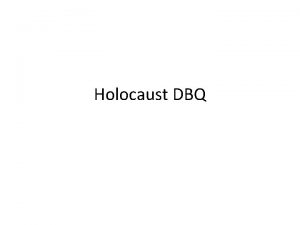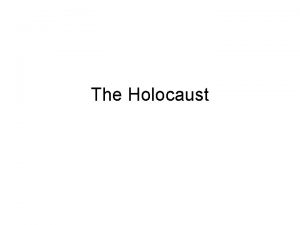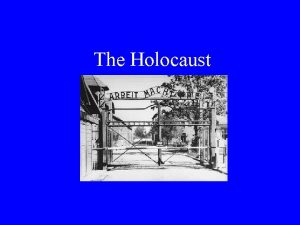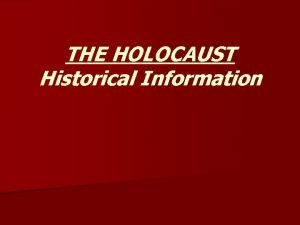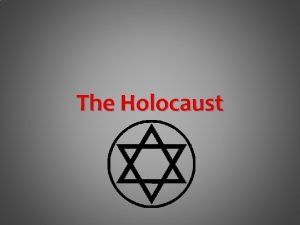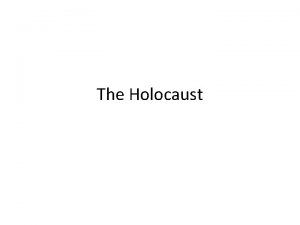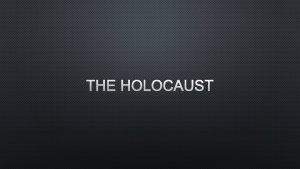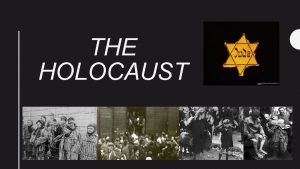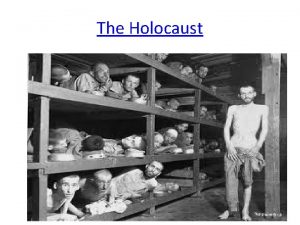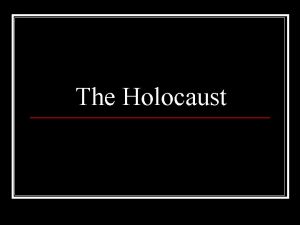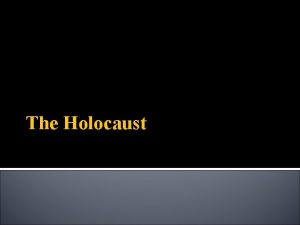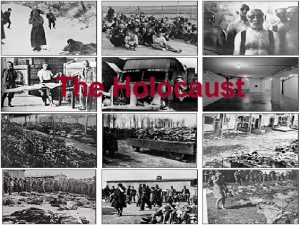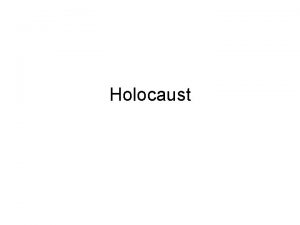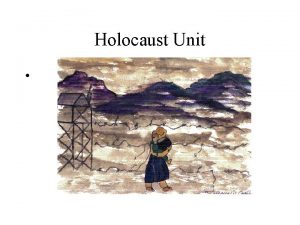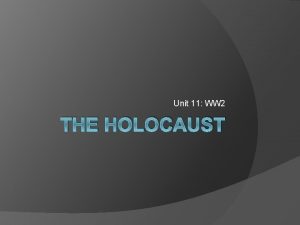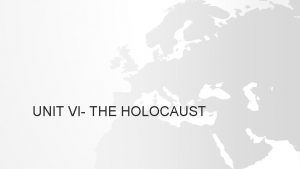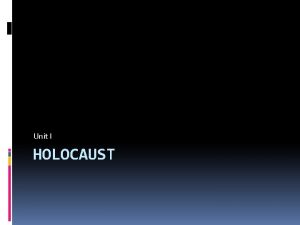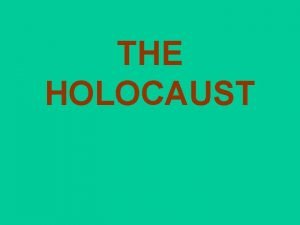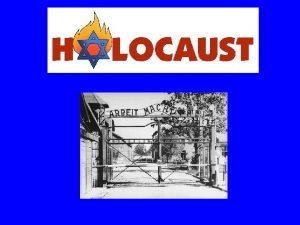Unit II The Holocaust English II Holocaust Definition



































- Slides: 35

Unit II: The Holocaust English II

Holocaust Definition • Holocaust originally derived from the Greek word holokauston, meaning “a completely (holo) burnt (kaustos) sacrificial offering” • The systematic state-sponsored persecution and • genocide of various ethnic, religious, and political groups during World War II by Nazi Germany and others The Jews were the main victims an estimated six million were killed

Anti-Semitism: prejudice and discrimination experienced by Jews • Jews do not share the Christian belief that Jesus is the Son of God, and many Christians considered this refusal to accept Jesus' divinity as arrogant. For centuries the Church taught that Jews were responsible for Jesus' death, not recognizing, as most historians do today, that Jesus was executed by the Roman government because officials viewed him as a political threat to their rule.

The following is an illustration from an Anti-Semitic children's textbook. The sign reads "Jews are not wanted here. “ --Germany, 1936

A Timeline of the Holocaust 1918 -present • Rise of the Nazi Party: • 1918 -1933 • The Nazi party became the most powerful political party in Germany

Nazification: 1933 -1939 Hitler came into power and soon changed the Nazi party’s political, social, and economic structure.

Hitler’s “Final Solution” • Adolf Hitler’s plan to annihilate the Jewish people • The genocide of the Jews was the culmination of a decade of Nazi policy under the rule of Adolf Hitler • Occurred in stages

Kristallnacht: Night of the Broken Glass • Many scholars date the beginning of the Holocaust itself to the anti-Jewish riots on November 9, 1938, in which Jews were attacked and Jewish property were vandalized across Germany.

The Ghettos: 1939 -1941 • The term "ghetto" originated from the name of the Jewish quarter in Venice, established in 1516. During World War II, ghettos were city districts (often enclosed) in which Reinhard Heydrich, Adolf Hitler, and the Germans forced the Jewish population to live under miserable conditions. Ghettos isolated Jews by separating Jewish communities from the non-Jewish population and from neighboring Jewish communities. The Nazis established over 400 ghettos.

A ghetto prisoner, Professor Ludwik Hirszfeld, wrote in his diary: "The streets are so over-populated, it is difficult to push one's way through. . . There always countless children inside the ghetto. . . Not all the German guards are murderers and executioners, but unfortunately, many of them do not hesitate to take up their guns and fire at the children. Every day--it is almost unbelievable--children are taken to hospitals with gunshot wounds. All Jews must wear the armband with the Star of David. The children are the only exceptions, and this makes it easier for them to smuggle food in. . . Horrifying sights are to be seen every day. . . One sees people dying, lying with arms and legs outstretched, in the middle of the road. Their legs are bloated, often frost-bitten, and their faces distorted with pain. . . I once asked a little girl: 'What would you like to be? ' 'A dog, ' she answered, 'because the guards like dogs. '"


The Camps: 1933 -1945 • Almost immediately following his rise to power, Hitler began the • • creation of concentration camps, which were designed to incarcerate political prisoners, criminals, and security risks. While conditions were horrible in these camps, and while the death rates were high, there is no evidence that they were used for extermination purposes. By the late 1930 s there were hundreds of concentration camps scattered throughout Germany. The death rates were so high, from malnutrition, typhus, and exhaustion that the disposal of corpses became a serious problem. In Dachau, one of the largest camps in Germany proper, crematoria were constructed for disposal of corpses.

Crematorium ovens in Dachau used to burn corpses

Crematorium stretcher where bodies were placed and slid into furnace

A body being dragged from the morgue into the crematorium by tongs

Bodies were picked up by tongs and placed onto stretchers

A morgue room in Dachau where bodies waited to be cremated

Bodies in the morgue room

Former prisoners of a concentration camp in Buchenwald stare out from the wooden bunks, in which they slept three to a "bed. " Elie Wiesel is pictured in the second row of bunks, seventh from the left, next to the vertical beam. (April 16, 1945)

Extermination Camps • Nazi extermination camps fulfilled the singular function of mass • • • murder. Unlike concentration camps, which served primarily as detention and labor centers, extermination camps were almost exclusively "death factories. " More than three million Jews were murdered in extermination camps, by gassing chambers and mass shootings. Bodies also were burned in crematoria. Auschwitz-Birkenau was the largest facility, which had both a labor camp (Auschwitz) and an extermination camp (Birkenau). Those too weak to work were executed immediately; others were used for slave labor first before execution.

Not only Jews were executed: The T-4 Euthanasia Program • The T-4 Euthanasia Program (1939 -1941) was • established to “maintain the genetic purity” of the German population by systematically killing citizens who were physically deformed, disabled, handicapped, or suffering from mental illnesses. Between 1939 and 1941, more than 200, 000 people were killed.

A Mosaic of Victims • Other “undesirable” groups were also murdered including: • Sinti-Roma (Gypsies) • Poles • Soviet military prisoners of war • Russians • Slavs • The mentally or physically disabled • Jehovah’s Witnesses • Communists Bringing the overall estimate of dead Holocaust victims to…

26 million people *The number 9 -11 million is usually listed as the more reliable number

Soviet prisoners of war in the Mauthausen concentration camp -- Austria, January 1942.

Resistance, Rescue, and Liberation: 1942 -1945 • People resisted by any means possible, from stealing a slice of bread to • • • sabotaging Nazi installations. Some survived through the heroics of neighbors; others were liberated by the Allies. Resistance and Rescue came from both Jews and non-Jews. Below: Bert and Anne Bochove, who hid 37 Jews in their pharmacy in Huizen, an Amsterdam suburb, pose here with their children. The two were named "Righteous Among the Nations. " The Netherlands – 1944 -1945.

Liberation! • As Allied troops moved across Europe in a series of offensives on Germany, • • they began to encounter concentration camp prisoners. Surprised by the rapid Soviet advance, the Germans attempted to hide the evidence of mass murder by demolishing camps and crematoria. The Soviets liberated Auschwitz, the largest extermination and concentration camp, in January 1945. When Allied troops entered the concentration camps and extermination camps, they discovered piles of bones and ashes--testimony to Nazi genocide. Soldiers also found thousands of survivors suffering from starvation and disease. There was abundant evidence of mass murder in Auschwitz. For example, they discovered hundreds of thousands of men's suits, more than 800, 000 women's outfits, and more than 14, 000 pounds of human hair. Nazi Germany was finally defeated in 1945.

A mass grave soon after camp liberation. Bergen-Belsen, Germany, May 1945

Several Characteristics of the Nazi Holocaust distinguish it from other genocides in history. 1. Premeditation • The Holocaust was an intentional and meticulously planned attempt to entirely eradicate certain groups of people.

Characteristics • 2. Efficiency It was an efficient and systematic attempt to assemble and murder as many victims as possible, using all of the resources and technology available.

Characteristics • 3. Scale The Holocaust was geographically widespread and conducted in all areas of Nazi-occupied territory, where Jews and other victims were targeted in what are now 35 separate European Nations.

Characteristics 4. Cruelty • The Holocaust was carried out without any mercy for babies or children, and victims were often made to suffer before being killed. • Dr. Josef Mengele, a medical officer at Auschwitz-Birkenau, was known as the “Angel of Death” for his sadistic and bizarre medical experiments. For example, he tried to change people’s eye color by injecting dye into their eyes. Many experiments were intended to produce “racially pure” babies and as weaponry/war research, but many prisoners did not survive.

Characteristics 5. The Victims • Certain groups were targeted in Hitler’s attempt to establish “racial hygiene” and the growth of the “master race. ”

Characteristics 6. The Death Toll • The estimated number of each group killed: v v v 5 -6 million Jews 1. 8 -1. 9 million Poles 200, 000 -800, 000 Roma and Sinti 200, 000 -300, 000 people with disabilities 10, 000 -25, 000 gay men 2, 000 Jehovah’s Witnesses

The Aftermath 1945 -present • After the war, Nazi perpetrators faced punishment for their war crimes and survivors began rebuilding their lives. • Two large and on-going international needs emerged as World War II ended: 1) retribution for perpetrators, and 2) the re-settlement of people uprooted by the war. These complex issues have occupied the hearts and minds of thousands around the world for decades. Even today, unresolved issues about the Holocaust remain. • With the establishment of the state of Israel in May 1948, refugees began streaming into that new sovereign state. The United States admitted an estimated 80, 000 Jewish displaced persons between 1945 and 1952.

There are 350, 000 Holocaust survivors today. • "No one yet knows what awaits the Jews in the twenty-first century, but we must make every effort to ensure that it is better than what befell them in the twentieth, the century of the Holocaust. " - Benjamin Netanyahu, Prime Minister of Israel (1996 -1999)
 Holocaust definition ap world history
Holocaust definition ap world history English unit conversions
English unit conversions Unit 10, unit 10 review tests, unit 10 general test
Unit 10, unit 10 review tests, unit 10 general test Hát kết hợp bộ gõ cơ thể
Hát kết hợp bộ gõ cơ thể Bổ thể
Bổ thể Tỉ lệ cơ thể trẻ em
Tỉ lệ cơ thể trẻ em Chó sói
Chó sói Thang điểm glasgow
Thang điểm glasgow Hát lên người ơi
Hát lên người ơi Môn thể thao bắt đầu bằng từ chạy
Môn thể thao bắt đầu bằng từ chạy Thế nào là hệ số cao nhất
Thế nào là hệ số cao nhất Các châu lục và đại dương trên thế giới
Các châu lục và đại dương trên thế giới Cong thức tính động năng
Cong thức tính động năng Trời xanh đây là của chúng ta thể thơ
Trời xanh đây là của chúng ta thể thơ Mật thư anh em như thể tay chân
Mật thư anh em như thể tay chân 101012 bằng
101012 bằng Phản ứng thế ankan
Phản ứng thế ankan Các châu lục và đại dương trên thế giới
Các châu lục và đại dương trên thế giới Thể thơ truyền thống
Thể thơ truyền thống Quá trình desamine hóa có thể tạo ra
Quá trình desamine hóa có thể tạo ra Một số thể thơ truyền thống
Một số thể thơ truyền thống Bàn tay mà dây bẩn
Bàn tay mà dây bẩn Vẽ hình chiếu vuông góc của vật thể sau
Vẽ hình chiếu vuông góc của vật thể sau Thế nào là sự mỏi cơ
Thế nào là sự mỏi cơ đặc điểm cơ thể của người tối cổ
đặc điểm cơ thể của người tối cổ Ví dụ giọng cùng tên
Ví dụ giọng cùng tên Vẽ hình chiếu đứng bằng cạnh của vật thể
Vẽ hình chiếu đứng bằng cạnh của vật thể Fecboak
Fecboak Thẻ vin
Thẻ vin đại từ thay thế
đại từ thay thế điện thế nghỉ
điện thế nghỉ Tư thế ngồi viết
Tư thế ngồi viết Diễn thế sinh thái là
Diễn thế sinh thái là Dạng đột biến một nhiễm là
Dạng đột biến một nhiễm là Số.nguyên tố
Số.nguyên tố
